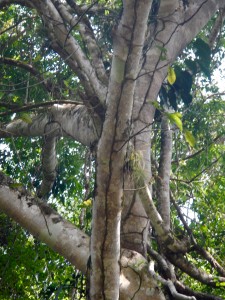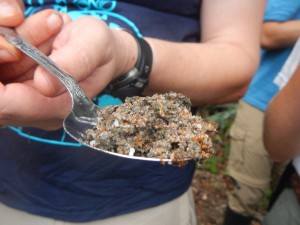This morning, we explored the symbiosis between Cecropia trees and Azteca ants. These species have a mutualistic relationship where the ants defend the trees from herbivores, and the trees provide a home for the ants. However, it takes some time for the ants to colonize the trees. We set out to study how young trees defend themselves against herbivores before colonization by Azteca ants. We tested the hypothesis that young Cecropia trees use chemical defenses, such as pheromones or toxins, to prevent herbivory. To do this, we gathered leaves from mature and juvenile trees. We put a leaf fragment from both ages into containers that each contained a generalist herbivore (grasshoppers, beetles, caterpillars, etc). Tomorrow, we will measure the mass change of each leaf to see if herbivorous insects determine if they prefer a certain age of leaf without the ants to deter them. As we were looking for Cecropia trees, we found a termite foraging trail winding up the underside the branches of a tree. They were relatively far away, and we weren’t able to identify them.
Next, we explored leafcutter ant colonies. I was amazed to discover that leafcutter ants have domesticated their own fungus, and the ants in a mature colony weigh as much and eat as much as an adult cow. The first colony we excavated was about a year old. It had a single volcano shaped entrance. The second colony was approximately 5 years old, and had 3 broad, mound shaped entrances. In addition, it had larger majors that helped defend the colony. Finally, we excavated a mature colony over 10 years old. It was very large, and the ants had cleared an area approximately 20 m by 20 m in the forest. This colony may have had millions of ants, including soldiers with very large mandibles.
As we were heading back, Lucrecia and I stopped to listen to the howler monkeys. We didn’t see any, but it was incredible to know they were so close, hiding amongst the trees. When you stop and listen, the jungle comes to life around you, and the variety of calls you can hear is astounding. It is such a magical experience to share this space with so many species I never would have dreamed of encountering.
*We dug down until we could just barely see the fungus chambers. The ants will quickly repair this damage. No queens were harmed in the making of this course.



Dear Ella,
Your field biology is very interesting. I am learning a lot from your reports. By the way, I am pleasantly impressed by your excellent writings.
Grandpa Ichiro